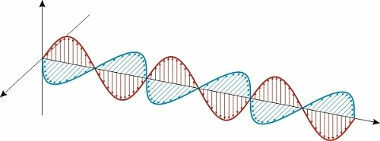THElight is a kind of electromagnetic wave visible, formed by the joint propagation of a electric field it is a magnetic. As is characteristic of electromagnetic radiation, light can propagate through various media and suffer speed changes when switching from one propagation medium to another. In a vacuum, light has velocity maximum equivalent to 3.0 x 10 8 m/s.

Electromagnetic waves are formed by the joint propagation of electromagnetic and electric fields
Light can also be understood as a continuous flow of energy-carrying particles.
Particle or wave?
The light has a double behavior, that is, it can be interpreted as a wave in certain situations and behave like a particle in specific cases. Thus, light is both a wave and a particle, and therefore has a dual behavior.
According to the proposal of Isaac Newton, in the 17th century, light could not be considered a wave, as it did not suffer phenomena such as diffraction, characteristic of a wave. For Newton, light should be formed by tiny particles, which had the ability to transport energy and undergo reflections and refractions. Back in the 17th century, Christiaan Huygens proposed that light should be interpreted with a wavelike character.
In the nineteenth century, the double slit experiment, performed by Young, indicated that light suffers interference and diffraction, characteristic wave phenomena.
Already in the 20th century, the ideas of Einstein and Max Planck they proposed that light was quantized, that is, formed by tiny energy packages called photons. However, these scientists have not ruled out the wave idea about light. Louis de Broglie's contributions, on the other hand, brought the concept of wave-particle duality of light.
Therefore, it is possible to understand that the propagation and interaction of light with certain media characterize it as an electromagnetic wave, but in some phenomena - as is the case with photoelectric effect –, light can be interpreted as a particle.
By Joab Silas
Graduated in Physics
Source: Brazil School - https://brasilescola.uol.com.br/o-que-e/fisica/o-que-e-a-luz.htm
